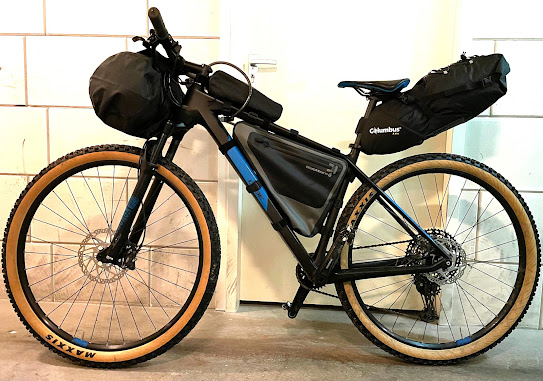It is a lot of stuff to bring with you on the bike and the first thing that I decided to sort it out was the types of bags that I would be using. I had a lot of questions for what combination of bags should I use. There are many options, like: small frame bag with water bottles or large frame bag with a camelbag in my back or a large frame bag with a water bladder inside? A small handlebar bag in front for the sleeping stuff or shove everything in the saddle bag? Where to hold the battery pack, mobile, passport, etc.
I read many blogs and videos on youtube from people that have done this type of thing before and shared a lot of tips. But at the end there is a lot of personal trial and error and preferences and the advice to adapt for the type of event one is going. So a lot of thinking and experimenting during the training rides prior to the big event is required and that is what I'm planning to do.
But there are a couple of general advices for any setup. The most common is to keep the heaviest items lower and centered on the bike to help with the center of gravity, the lightest items should be on the handlebar to avoid messing with the ability to manage and steer the bike and make sure they if you have a large saddle bag, they are very secure on the bike to avoid getting the bike off balance.
Another really important point is that a lot of stuff means and bags also mean a lot of weight. And more weight means harder climbing. So, it is not only the weight of everything one has to bring, which I will create a post later, but the eight of the bags themselves. Which added a lot of complexity to my search. It is not only a matter of throwing money at it and buy the most expensive. It has to be also light and considering that I'm not sure I will do an event like this more than once (I know, said the same thing about the Etape du Tour de France), I don't need to buy the strongest.
My research for the cheapest and lightest bags showed the follow results:
Saddlebag
Zefal Z Adventure R17 - 17l - 620g - 60 euros
Apidura Expedition - 17l - 425 g - 149 euros
Ortlieb 16.5 l - 456 g - 135 euros
Topeak backloader - 565 g - 65 euros
Woho - 13 l - 390 g - 85 euros
Columbus - 18 l - 355 g - 42 euros
Handlebar bag
ORTLIEB HANDLEBAR PACK - 15L - 420g -
RESTRAP BAR STUURTAS - 14 L - 550g - 100 euros
Zefal Z-Adventure - 10 l - 340 g - 50 euros
Apidura Expedition Handlebar - 9 l - 250 - 109 euros
Apidura Expedition Handlebar - 14 l - 275 - 118 euros
Topeak front loader - 8 l - 325 g - 60 euros
No brand - 15 l - 200 g - cheap as you wouldn't believe






